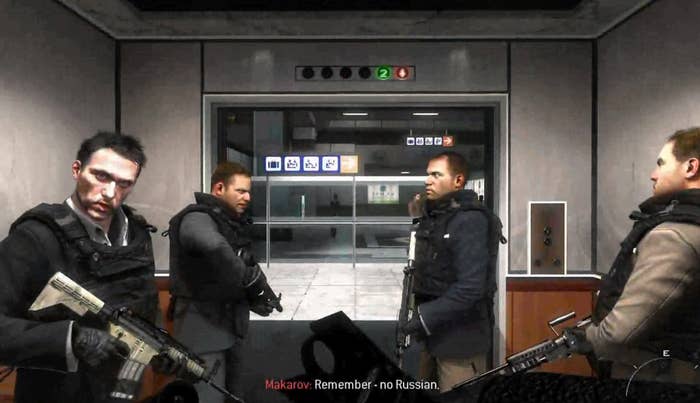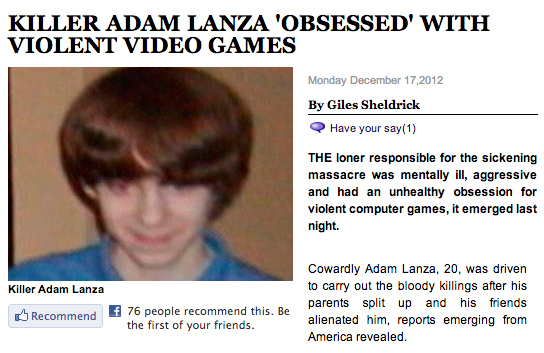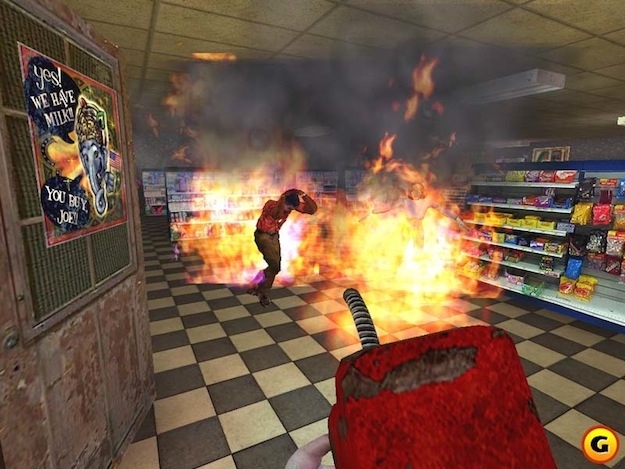
Update, July 1st, 2013: An account linked to Adam Lanza reveals an obsession with a first-person shooter called Combat Arms.
****
Adam Lanza was a gamer.
This fact has been reported, re-reported, and rehashed to the extent that it's now part of the killer's capsule bio: Young. White. Male. Asperger's. Loner. Gamer. This was predictable — not just that this young, withdrawn man played games, as so many do, or that they were violent, as so many are, but also that this detail would capture people's attention; that the media would repeat it in an insinuating way, and that it would make the public uneasy. My son plays those games. My son loves those games. I play those games.
Even more predictable, though, was this response:
Fox News links Sandy Hook shooting to violent video games. Of course. http://t.co/fRBWpSmD
 Fox News links Sandy Hook shooting to violent video games. Of course. http://t.co/fRBWpSmD-- Kotaku
Fox News links Sandy Hook shooting to violent video games. Of course. http://t.co/fRBWpSmD-- Kotaku
CNN/MSNBC: coverage of the Sandy Hook tribute. Fox: some dude ranting about video games.
 CNN/MSNBC: coverage of the Sandy Hook tribute. Fox: some dude ranting about video games.-- Jesse Taylor
CNN/MSNBC: coverage of the Sandy Hook tribute. Fox: some dude ranting about video games.-- Jesse Taylor
Astounding ignorance from The Independent. Blame video games in the headline, no mention of them at all in the article http://t.co/6zPrqHNr
 Astounding ignorance from The Independent. Blame video games in the headline, no mention of them at all in the article http://t.co/6zPrqHNr-- Lewie Procter
Astounding ignorance from The Independent. Blame video games in the headline, no mention of them at all in the article http://t.co/6zPrqHNr-- Lewie Procter
And it's a response I understand. I remember the misinformed coverage of music and games after Columbine, and I've had heated email exchanges with the anti-game crusader Jack Thompson, who once led the closest thing this country has ever had to a cohesive anti-game lobby. I've felt defensive about this before, both as a child demanding access to what were in retrospect completely inappropriate games, and as an adult who plays and is paid to occasionally write about them. I feel a hint of defensiveness now too, and cringe at conclusion-jumping like this:

But this discussion has become stale and repetitive, and the knee-jerk defensiveness of gamers and games writers has become dogma. Hashing out the same gamers-as-victim fantasy — which was constructed at a time when gaming really was a fragile subculture, not a $50 billion-plus industry — seems both absurd and insensitive in the shadow of real, and heartbreakingly pure, victimhood.
Take this, from The Inquisitr:
The saying “guns don’t kill people, people kill people” comes to mind in this instance. Video games don’t kill people; people kill people. In fact, the most deadly school massacre in the United States occurred in 1927 at the Bath School in Bath Township, Michigan. No video games were available in 1927, yet 45 children aged 7 to 14 lost their lives.
This line may have made sense in the '90s, when Doom — a proudly violent and necessarily unrealistic game — was questionably labeled as a "murder simulator" and blamed outright for multiple school shootings. But today, it has a disingenuous ring to it.
Our understanding of the relationship between media and violence has become more nuanced since the early days of the first person shooter (update: for those of you who don't want to follow the link, it describes a *lack* of proven link between gaming and murder, internationally).
In the meantime, real, existential threats against the gaming industry, in the media, and in Washington, have faded away.
And in response, the gaming industry has grown more brazen and complacent — in those last few years before Thompson's humiliating disbarment, as gaming went well and fully mainstream, emboldened developers raced to create the most offensive games possible. They had won, and it was time to gloat. I remember the bizarre resurrection of the infamous Postal franchise, Postal 2, a game that let you urinate on other characters until they vomited. The game cheekily encouraged players to terrorize Habib's stereotypically appointed corner store, and gave players a can of gasoline, matches, and (wink!) a captive room of dancing gay men. I remember Soldier of Fortune, a game that proudly advertised part-by-part bodily destruction in character models. You could blow off arms and legs, or hollow out opponents' guts.

Games like Postal 2 and the Soldier of Fortune series were not representative of the industry as a whole and were clearly intended to offend, so it was easy for defensive gamers to deflect criticism — these were niche titles, after all. But Grand Theft Auto 3 was not a niche title, nor were any of its wildly successful follow-ups. The Battlefield and Call of Duty series have become some of the most successful entertainment franchises in history. Much of the deliberate provocation of the early 2000s has become standard in the world's top-selling (and far more realistic) games. Modern Warfare II's notorious airport massacre scene drew criticism, of course. But the next sequel in the franchise became the fastest selling game in history.
All this is to say that while uninformed anti-game sensationalism may be unproductive, gamers' reflexive defensiveness is worse. It's prevented us from having a meaningful conversation about an industry that is emotionally and morally stunted, where per-title revenue can dwarf even the most successful films of all time but which seems immune from discussions of taste and artistic merit. A higher-up at one of the largest game publishers in the world once confided in me that when his bosses showed him early footage from a popular first-person shooter produced by another studio in the company, he couldn't bring himself to watch to the end.
It's not crazy to feel uneasy that young men's most influential entertainment products, the cultural touchstones they do and will reminisce about in adulthood, are built around the premise of empathizing with a man with a gun in his hand, who kills not in the crudely symmetrical and grim manner of war but gleefully commits mass slaughter. These games become more like action movies with each passing technological generation, approaching photorealism and pulling players into actual, active theaters of war. These are first-person games with first-person narratives, differentiated from films only by a lack of distinction between viewer and protagonist.
Historically, it's easy to see how the industry ended up here, how one mega-hit FPS franchise led to another, then another, then another. But that doesn't make these games any easier to defend on their merits — and it doesn't mean that this is the games industry we necessarily want. These games are cultural monuments to violence; they are about killing and being killed, and sometimes little more. I've played and enjoyed plenty of them, and I imagine I'll keep doing so. But to dismiss outright worries about what these games are, and why people enjoy them, is a lazy cop out.
We can let ourselves feel guilty as we play these games, and talk about why that might be. We can allow ourselves to wonder what it means that members of Seal Team Six were disciplined by the Navy for divulging classified information in a video game consultation. We can freely ask if these games have any causal force when it comes to violence, or if they're just a reflection of the culture of a country that's been at war for a solid decade.
We can feel free to acknowledge that the thought of truly violent and insane people playing and enjoying games about killing makes the stomach churn, in the same way we might be discomforted to find out a killer enjoyed beloved but violent movies. We can stop obsessing over the media blaming the games industry — it hasn't had real consequences in this country before, and it's doubtful that it will anytime soon — and take a moment to consider what's it's become, and what it should be. This is good. And so is this.
Most of all, we can let the media say it loud and clear: Adam Lanza played games. Probably violent ones. Stating that fact is not a problem. Pretending that it doesn't — or rather, absolutely can't — tell us anything about a person? That is.

